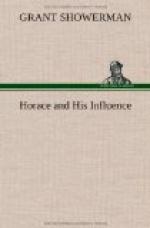In Germany, the Renaissance movement had its pronounced beginning at Heidelberg. In that city began also the active study of Horace, in the lectures on Horace in 1456. The Epistles were first printed in 1482 at Leipzig, the Epodes in 1488, and in 1492 appeared the first complete Horace. Up to 1500, about ten editions had been published, only those of 1492 and 1498 being Horace entire, and none of them with commentary except that of 1498, which had a few notes and metrical signs to indicate the structure of the verse. The first German to translate a poem of Horace was Johann Fischart, 1550-90, who rendered the second Epode in 145 rhymed couplets. The famous Silesian, Opitz, “father of German poetry,” and his followers, were to Germany what the Pleiad were to France. His work on poetry, 1624, was grounded in Horace, and was long the canon. Bucholz, in 1639, produced the first translation of an entire book of the Odes in German. Weckherlin, 1548-1653, translated three Odes, Gottsched of Leipzig, 1700-66, and Breitinge of Zurich, confess Horace as master of the art of poetry, and their cities become the centers of many translations. Guenther, 1695-1728, the most gifted lyric poet of his race before Klopstock, made Horace his companion and confidant of leisure hours. Hagedorn, 1708-54, forms his philosophy from Horace,—“my friend, my teacher, my companion.” Of Ramler, for thirty-five years dictator of the Berlin literary world, who translated and published some of the Odes in 1769 and was called the German Horace, Lessing said that no sovereign had ever been so beautifully addressed as was Frederick the Great in his imitation of the Maecenas ode. The epoch-making Klopstock, 1724-1803, quotes, translates, and imitates Horace, and uses Horatian subjects. Heinse reads him and writes of him enthusiastically, and Platen, 1796-1835, is so full of Homer and Horace that he can do nothing of his own. Lessing and Herder are devoted Horatians, though Herder thinks that Lessing and Winckelmann are too unreserved in their enthusiasm for the imitation of classical letters. Goethe praises Horace for lyric charm and for understanding of art and life, and studies his meters while composing the Elegies. Nietzsche’s letters abound in quotation and phrase. Even the Church in Germany shows the impress of Horace in some of her greatest hymns, which are in Alcaics and Sapphics of Horatian origin. To speak of the German editors, commentators, and critics of the nineteenth century would be almost to review the history of Horace in modern school and university; such has been the ardor of the German soul and the industry of the German mind.
iv. IN SPAIN




